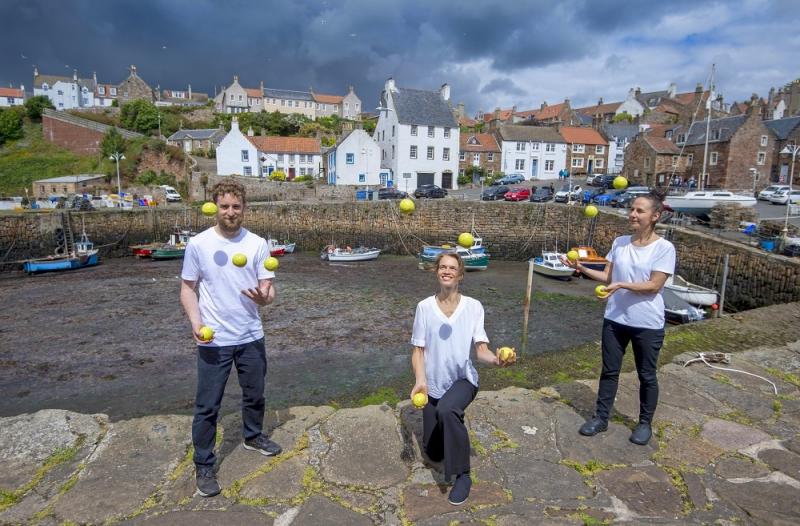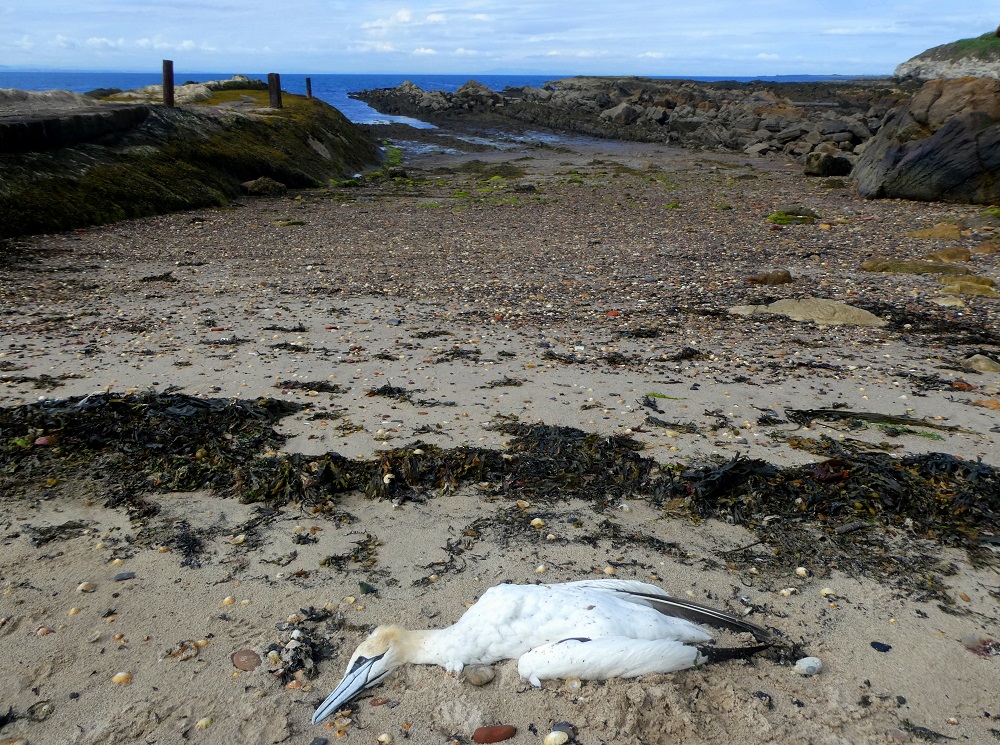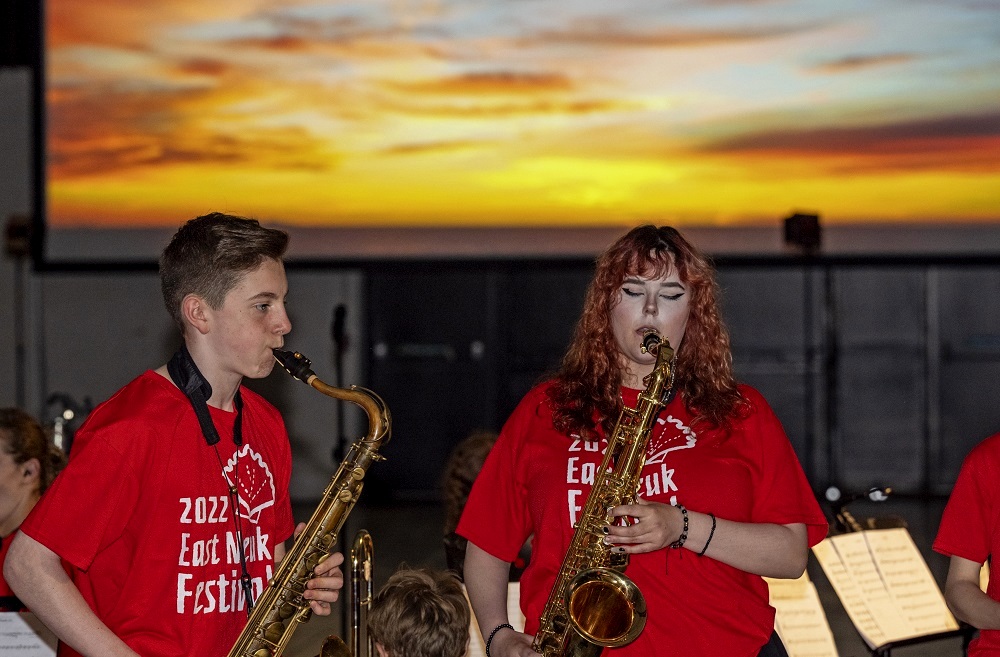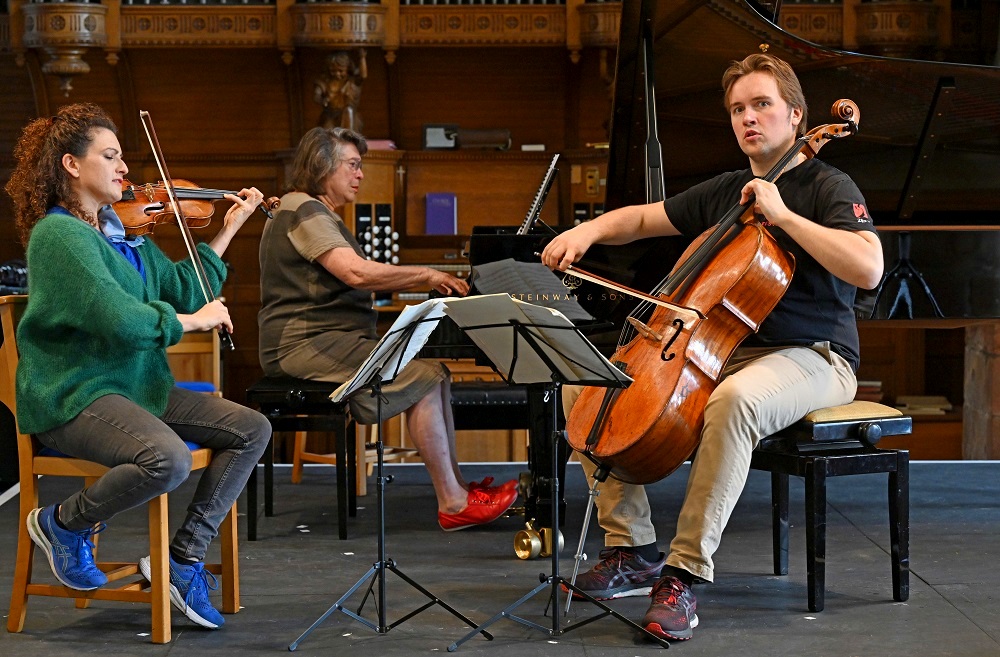theartsdesk at the East Neuk Festival 2022 - on Cloud Nine for five days of the greatest music-making | reviews, news & interviews
theartsdesk at the East Neuk Festival 2022 - on Cloud Nine for five days of the greatest music-making
theartsdesk at the East Neuk Festival 2022 - on Cloud Nine for five days of the greatest music-making
Five supreme pianists, two top string quartets and so much more on the Fife coast

Last year’s relatively slimline East Neuk Festival felt like a feast in time of plague. This July everything was back to full strength in numerous venues, with the most remarkable line-up, and the greatest single day of concerts, I feel certain, ENF has ever seen. But that was in spite of the apocalyptic signs all around.
Covid is, of course, rampant again, and casualties included guitarist Sean Shibe as well as the festival’s director Svend McEwan-Brown, who had to head home at the midway point with a stricken husband. Avian flu had hit the seabird community; more than half the gannet population of Bass Rock over the waters had died, the nearby Isle of May was closed to visitors, and corpses appeared with alarming regularity on local beaches (pictured below).
There was time to mourn the losses of the past two years in what has always seemed to me the perfect festival programming – no theme, but a careful flow and a regular presence of certain artists. Right at the start, though not officially designated as such, James MacMillan’s Memento as played in Kilrenny Church by the Elias Quartet stood as a poignant memorial.
This first of 10 concerts I attended, all of the highest order, had a rare continuity, bracing as well as introspective. The delicious Haydn Quartet in G, Op. 33 No. 5, would be mirrored at the other end of the festival by more lightness of being in Symphony No. 82, “The Bear”, as vivaciously played by the Scottish Chamber Orchestra under its live-wire former bassoonist, Peter Whelan. The revelation of Concert 1 to me was the best work I’ve heard yet by another former SCO member, Sally Beamish. Reed Stanzas is a fully-fledged string quartet, her third, touched with the birdsong all around her when she composed it in a seaside cottage on the island of Harris. It starts with a folk fiddler from a distance – Donald Grant, the Elias’s second violinist, for whom this was specially written. I didn’t know about his refreshment of Gaelic tradition; his own arrangements – more compositions incorporating original tunes – flanked the Beamish work in high style. I want the CD now.  Then it was on to the big venue used exclusively last year, the Bowhouse along the coast, for the first of two festival fusions/happenings. Brown always honours the involvement of local musicians of all ages (two of them pictured above). This year it was the turn of Fife Youth Jazz and StAmp (St Andrews Music Participation) Project Children’s Band working alongside The Wallace Collection and the excellent Tullis Russell Works Band to provide original scores for a series of short films about the Scottish weather made by Pittenweem-born, Edinburgh University trained musician David Behrens. Thunderplump was the splendid title (dictionary definition: “Scottish, Northern Irish A heavy and sudden shower of rain accompanied by thunder and lightning”; there were plenty of thunderplumps around in the form of cumulo-nimbus clouds in the changeable and exhilarating Fife weather of the festival week).
Then it was on to the big venue used exclusively last year, the Bowhouse along the coast, for the first of two festival fusions/happenings. Brown always honours the involvement of local musicians of all ages (two of them pictured above). This year it was the turn of Fife Youth Jazz and StAmp (St Andrews Music Participation) Project Children’s Band working alongside The Wallace Collection and the excellent Tullis Russell Works Band to provide original scores for a series of short films about the Scottish weather made by Pittenweem-born, Edinburgh University trained musician David Behrens. Thunderplump was the splendid title (dictionary definition: “Scottish, Northern Irish A heavy and sudden shower of rain accompanied by thunder and lightning”; there were plenty of thunderplumps around in the form of cumulo-nimbus clouds in the changeable and exhilarating Fife weather of the festival week).
The heart did somewhat sink at the announcement of nine films, and Behrens’ work was interesting at best – the snow sequence – while I’m not sure that jazz works as accompaniment to natural phenomena, not even the concluding piece by Neil Brand, who kicked off with splendid accompaniment to Buster Keaton film The Boat. The overall impact wasn’t quite on the level of 2017’s De Profundis, an immersive Bowhouse experience, or 2018 ‘s Lost at Sea, a haunting collaboration with veteran local fisherman Ronnie Hughes, but it happened, and that’s of vital importance. And the film of everyone taking a bow was sheer laugh-out-loud delight.
 The other Bowhouse experiment this year, Light the Lights, should have involved Shibe as well as violinist Benjamin Baker (with whom he’d been working on retreat in Fife) and Gandini Juggling. What we had were less than first-rate pieces involving violin (the opening Bach excepted) made interesting by the jugglers’ participation. You can only go so far with balls and batons, but there was a spectacular if scaled-down homage to Ligeti’s Poème symphonique for 100 Metronomes, and the final illuminations were gorgeous. Unfortunately the performance platform had to be lowered so the jugglers didn’t hit the lights, and that meant we couldn’t see all of them, nor (more crucially) dancer James Pett.
The other Bowhouse experiment this year, Light the Lights, should have involved Shibe as well as violinist Benjamin Baker (with whom he’d been working on retreat in Fife) and Gandini Juggling. What we had were less than first-rate pieces involving violin (the opening Bach excepted) made interesting by the jugglers’ participation. You can only go so far with balls and batons, but there was a spectacular if scaled-down homage to Ligeti’s Poème symphonique for 100 Metronomes, and the final illuminations were gorgeous. Unfortunately the performance platform had to be lowered so the jugglers didn’t hit the lights, and that meant we couldn’t see all of them, nor (more crucially) dancer James Pett.
Bowhouse acoustics aren’t great for piano, but they do highlight other instrumental timbres, above all Alec Frank-Gemmill’s glorious horn tone in the Schubert Octet. This provided a second chance to hear the Elias Quartet, working together in a visibly joyous way that you didn’t see from the wind players (though all phrased and projected superbly). I wonder if it might not have been a different sight if we’d had four of the players from the Magnard Ensemble instead. Their one concert in another excellent sounding-board, St Ayle’s Church Cellardyke (a new venue for me) had plenty of charm on display, not least when oboist Mana Shibata said she thought the variations in Nielsen’s masterpiece of a wind quintet showed off the different personalities well: what, clarinettist Joseph Shiner as a drunk? I was thrilled to hear this great work live for the first time, but the rest of the programme was also beautifully threaded, starting with a horn solo (from Anna Drysdale) in Malcolm Arnold’ Fantasy followed by his delectable Divertimento for Wind Trio and Debussy’s Syrinx played from the gallery by Suzie Clements between MacMillan’s Untold and the Nielsen. I want to see much more of these consummate players.
Unquestionably, though, the greatest day in this or (in my experience) any other festival came in three extraordinary concerts from 11.30 in the morning to about 9.30 at night. Pavel Kolesnikov and Samson Tsoy, who kicked off the day, had already featured a Schubert work for four hands before the two great Piano Trios as played by their mentor and friend Elisabeth Leonskaja with her goddaughter Lisa Ferschtman and the wonderful young cellist Ivan Karizna (another replacement, giving us three generations of musicians in a single performance; all three pictured below)  I had to miss the first of the trio concerts, but I’ve heard Ferschtman and Leonskaja playing the trios at the Wigmore Hall, as well as Kolesnikov and Tsoy three times before in the F minor Fantasie. What I witnessed this time was even more wonderful.
I had to miss the first of the trio concerts, but I’ve heard Ferschtman and Leonskaja playing the trios at the Wigmore Hall, as well as Kolesnikov and Tsoy three times before in the F minor Fantasie. What I witnessed this time was even more wonderful.
Likewise with the morning concert on the big day: the piano duo, partners in life as well, had featured their magnificent Stravinsky Rite of Spring reimagined at their Ragged Music Festival. But the whole programme this time was pure genius – anticipation of the Rite in the lighter touch of Poulenc’s Sonata for Four Hands and the kind of festival contrasts you dream of: three Beethoven Marches, showcasing the wit and warmth for which the composer isn’t sufficiently celebrated, interwoven with “Furious Chorale” and “Beating – Quarrelling” from Kurtág’s Játékok or Children’s Games (the latter piece must be the most fun for learning of any piano miniature, a dialogue of single notes between the two players, pictured below).  An exquisite Kurtág Purcell arrangement and another Játékok piece, more elegiac, led straight to the opening pipings of Stravinsky’s masterpiece. You learn so much more about it when the playing is this clear as well as revelatory at both ends of the dynamic scale. And what could be sweeter than Kolesnikov reaching around his partner to play the melody in “Spring Rounds”. The duo kept focus throughout; it was for the audience to go wild at the end.
An exquisite Kurtág Purcell arrangement and another Játékok piece, more elegiac, led straight to the opening pipings of Stravinsky’s masterpiece. You learn so much more about it when the playing is this clear as well as revelatory at both ends of the dynamic scale. And what could be sweeter than Kolesnikov reaching around his partner to play the melody in “Spring Rounds”. The duo kept focus throughout; it was for the audience to go wild at the end.
Another quantity known to me, Leonskaja’s unintervalled odyssey through the last three Beethoven piano sonatas seemed to reach out beyond the realms of the pianistically possible this time, everything in place, all of it perfectly right, from the intensely human variations of Op, 109 to their metaphysical counterpart in Op. 111 – also returning to the earthly, but reaching towards paradise. Each time I learn more about the music, find more sense as well as essence in it: this is the gift of a truly great pianist and a profound human being.
It was clear that there would be no anti-climax in the evening concert from the way that Veronika Jarůšková and Peter Jarůšek of the Pavel Haas Quartet had joined with hypersensitive pianist Boris Giltburg to live every nuance of Dvořák’s early G minor and later E minor (“Dumky”) Piano Trios; it simply isn’t necessary to apologise for the relative youth of the first work when such musicianship makes every note live. The dancing joy in parts of the “Dumky” Trio was raised in excelsis for the Piano Quinter in A major (rehearsal pictured below).  There are those who think the Pavel Haas players go too far in their exuberance and their extremes, but that living of every moment means that they simply own Janáček’s Second Quartet – searing, unforgettable at the end of a Thursday concert with Suk and Korngold given equal care – as well as the sunlit uplands of Dvořák and the dark intensity of Brahms’s F minor Quintet.
There are those who think the Pavel Haas players go too far in their exuberance and their extremes, but that living of every moment means that they simply own Janáček’s Second Quartet – searing, unforgettable at the end of a Thursday concert with Suk and Korngold given equal care – as well as the sunlit uplands of Dvořák and the dark intensity of Brahms’s F minor Quintet.
The partnership with Giltburg is a dream; you see every value in each chord or phrase he articulates so carefully in the face, and – full disclosure re an hour’s involvement in the festival this year here – when I gave a talk on the Russian tradition after the Dvořák trios morning concert, it was clear that Giltburg has the same miraculous adjustment to the right emotion of the moment as what we heard in the examples I played from Richter, Gilels and others.  All else was a bonus after this great day. I squeezed in an interlude to be charmed by the spontaneity and skill of oud player Rihab Azar (pictured above) working so well – and playing reels, no less – with affable folk singer-songwriter Luke Daniels, and wish there hadn’t been clashes so I could have heard more of Saturday’s parallel world-classical and jazz events; reports had it that East African singer and lyre player Rapasa Otieno, the only black person to be seen in the East Neuk in five days, alas, made a big impression.
All else was a bonus after this great day. I squeezed in an interlude to be charmed by the spontaneity and skill of oud player Rihab Azar (pictured above) working so well – and playing reels, no less – with affable folk singer-songwriter Luke Daniels, and wish there hadn’t been clashes so I could have heard more of Saturday’s parallel world-classical and jazz events; reports had it that East African singer and lyre player Rapasa Otieno, the only black person to be seen in the East Neuk in five days, alas, made a big impression.
On Sunday, the final day, Whelan worked wonders with the SCO in the Haydn symphony and Anna Dennis, fresh from her triumph in new opera Violet, hit the expressive and literal heights in “Martern aller Artern” following “Traurigkeit” in the sequence from Mozart’s Die Entführung aus dem Serail. If we left the Elysian fields behind in Beethoven’s Eighth, that was more to do with the tricksy nature of this ingenious work and a fuller orchestra sounding a tad harsh in Bowhouse acoustics. And it was hard to adjust to Christian Zacharias’s sonorous, technically fine but charmless Schubert back at Crail after the supreme communicators. No matter: we had our visions, and so many of them.
Explore topics
Share this article
The future of Arts Journalism
You can stop theartsdesk.com closing!
We urgently need financing to survive. Our fundraising drive has thus far raised £49,000 but we need to reach £100,000 or we will be forced to close. Please contribute here: https://gofund.me/c3f6033d
And if you can forward this information to anyone who might assist, we’d be grateful.

Subscribe to theartsdesk.com
Thank you for continuing to read our work on theartsdesk.com. For unlimited access to every article in its entirety, including our archive of more than 15,000 pieces, we're asking for £5 per month or £40 per year. We feel it's a very good deal, and hope you do too.
To take a subscription now simply click here.
And if you're looking for that extra gift for a friend or family member, why not treat them to a theartsdesk.com gift subscription?
more Classical music
 First Person: clarinettist Oliver Pashley on the new horizons of The Hermes Experiment's latest album
Compositions by members of this unusual quartet feature for the first time
First Person: clarinettist Oliver Pashley on the new horizons of The Hermes Experiment's latest album
Compositions by members of this unusual quartet feature for the first time
 Gesualdo Passione, Les Arts Florissants, Amala Dior Company, Barbican review - inspired collaboration excavates the music's humanity
At times it was like watching an anarchic religious procession
Gesualdo Passione, Les Arts Florissants, Amala Dior Company, Barbican review - inspired collaboration excavates the music's humanity
At times it was like watching an anarchic religious procession
 Classical CDs: Camels, concrete and cabaret
An influential American composer's 90th birthday box, plus British piano concertos and a father-and-son duo
Classical CDs: Camels, concrete and cabaret
An influential American composer's 90th birthday box, plus British piano concertos and a father-and-son duo
 Cockerham, Manchester Camerata, Sheen, Martin Harris Centre, Manchester review - re-enacting the dawn of modernism
Two UK premieres added to three miniatures from a seminal event of January 1914
Cockerham, Manchester Camerata, Sheen, Martin Harris Centre, Manchester review - re-enacting the dawn of modernism
Two UK premieres added to three miniatures from a seminal event of January 1914
 Kempf, Brno Philharmonic, Davies, Bridgewater Hall, Manchester review - European tradition meets American jazz
Bouncing Czechs enjoy their Gershwin and Brubeck alongside Janáček and Dvořák
Kempf, Brno Philharmonic, Davies, Bridgewater Hall, Manchester review - European tradition meets American jazz
Bouncing Czechs enjoy their Gershwin and Brubeck alongside Janáček and Dvořák
 Solomon, OAE, Butt, QEH review - daft Biblical whitewashing with great choruses
Even a top soprano and mezzo can’t make this Handel paean wholly convincing
Solomon, OAE, Butt, QEH review - daft Biblical whitewashing with great choruses
Even a top soprano and mezzo can’t make this Handel paean wholly convincing
 Two-Piano Gala, Kings Place review - shining constellations
London Piano Festival curators and illustrious friends entertain and enlighten
Two-Piano Gala, Kings Place review - shining constellations
London Piano Festival curators and illustrious friends entertain and enlighten
 Echo Vocal Ensemble, Latto, Union Chapel review - eclectic choral programme garlanded with dance
Beautiful singing at the heart of an imaginative and stylistically varied concert
Echo Vocal Ensemble, Latto, Union Chapel review - eclectic choral programme garlanded with dance
Beautiful singing at the heart of an imaginative and stylistically varied concert
 Scott, Irish Baroque Orchestra, Whelan, RIAM, Dublin review - towards a Mozart masterpiece
Characteristic joy and enlightenment from this team, but a valveless horn brings problems
Scott, Irish Baroque Orchestra, Whelan, RIAM, Dublin review - towards a Mozart masterpiece
Characteristic joy and enlightenment from this team, but a valveless horn brings problems
 Classical CDs: Voice flutes, flugelhorns and froth
Baroque sonatas, English orchestral music and an emotionally-charged vocal recital
Classical CDs: Voice flutes, flugelhorns and froth
Baroque sonatas, English orchestral music and an emotionally-charged vocal recital
 Kanneh-Mason, Britten Sinfonia, Shave, Milton Court - a grin and a big beaming smile
A pair of striking contemporary pieces alongside two old favourites
Kanneh-Mason, Britten Sinfonia, Shave, Milton Court - a grin and a big beaming smile
A pair of striking contemporary pieces alongside two old favourites

Add comment